8 Best Eye Exercises to Improve Vision
Medically reviewed by our experts


Eye exercises to improve vision offer practical ways to support visual comfort and coordination in our screen-dominated world. These techniques may help reduce fatigue, maintain focus flexibility, and support the muscles that control eye movement. While they won’t correct structural vision problems, regular practice can contribute to better visual stamina throughout the day. The eight exercises below combine muscle coordination work with nutritional support to address common visual challenges.
Why Eye Muscle Coordination Matters
Vision relies on constant muscle adjustments within and around your eyes. Six external muscles control each eye’s position and movement. Internal muscles adjust lens shape for focusing at different distances. These muscles work together every time you shift your gaze from your phone to the horizon.
The strength and coordination of these muscles influence how quickly and accurately your eyes respond. Eye strengthening exercises target these systems through repetitive movement patterns. When muscles coordinate smoothly, visual tasks feel less tiring. Poor coordination may contribute to slower focus changes or visual discomfort during extended reading.
The mechanics of focusing
The ciliary muscle encircles your lens and controls its shape. This process happens automatically but requires muscular effort. Different distances demand different lens configurations:
- Near vision – requires contraction of internal focusing muscles
- Far vision – muscles relax for a flatter lens shape
Constant near work keeps these muscles contracted for hours. This sustained tension may slow your ability to refocus on distant objects quickly.
Before You Begin: Safety, Frequency, and Supplement Support
Start gently with these techniques and stop if you experience pain or dizziness. Use adequate lighting to avoid unnecessary strain. Listen to your body’s signals and build duration gradually. Two to three practice sessions daily works well for most people without causing overexertion.
Nutritional support plays a key role in maintaining eye structure and function. Several nutrients contribute to visual health through different mechanisms. The worst foods for eye health significantly impact long-term visual comfort:
- Lutein – supports macular structure
- Zeaxanthin – may help filter light stress
- Zinc – contributes to visual enzyme function
- Vitamin A – maintains surface eye integrity
For added visual support, SightMax by Nature’s Blast offers a blend of targeted nutrients formulated to support overall eye structure and comfort. This comprehensive formula combines lutein, zeaxanthin, zinc, and vitamin A in balanced amounts. Each serving provides nutrients that may help maintain macular density and support the eye’s natural filtering mechanisms.
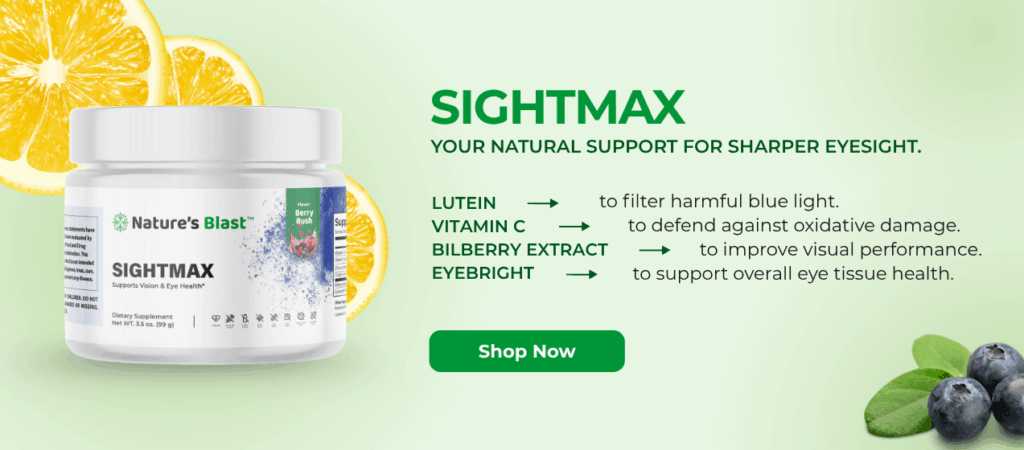
The formula also includes bilberry extract, which contains anthocyanins that may support microcirculation in eye tissues. Beta-carotene provides additional vitamin A precursor support. Together, these ingredients complement your eye exercises routine by nourishing the structures your exercises strengthen. Some people find that combining daily supplementation with regular practice creates a complete approach to maintaining visual comfort and function as they age.
8 Effective Eye Exercises to Improve Vision Naturally
Now that you understand the basics of eye muscle coordination and visual support, let’s explore simple eye exercises to improve vision you can practice anywhere. These movements are easy to learn, require no equipment, and can help reduce daily eye fatigue while supporting focus flexibility and overall comfort.
Exercise 1: Blink and Refresh
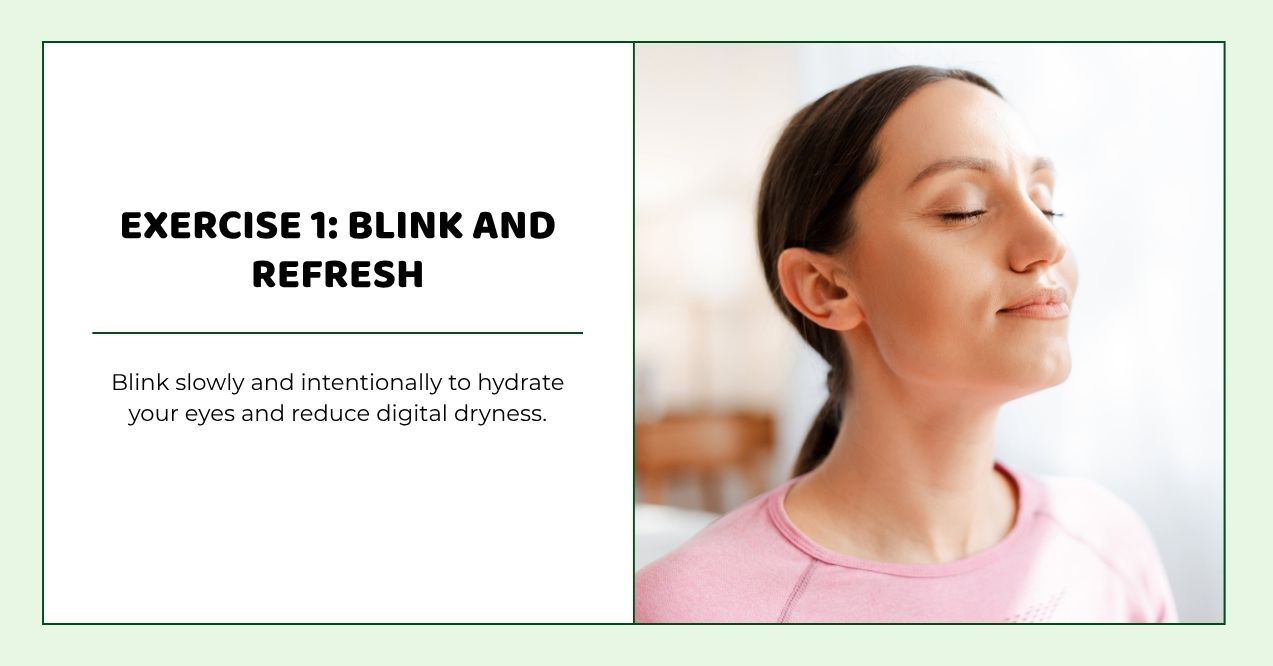
Intentional blinking maintains your tear film and cleanses surface debris. Screen use often reduces natural blink rate by half. This simple technique refreshes your eyes during extended digital sessions.
- Blink slowly 10 times in succession
- Close your eyes gently and hold for 5 seconds
- Open your eyes and rest briefly
- Repeat this pattern 3 times throughout your workday
The motion spreads tears evenly across your cornea and stimulates oil glands in your eyelids. Regular practice of these eye exercises to improve vision may reduce dryness sensations. Vision training often starts with this foundational technique.
Exercise 2: Focus Shift Challenge
This movement trains flexible focusing between near and far distances. Extended close work can reduce accommodation speed. Eye exercises for better vision like this one may help maintain focusing flexibility throughout the day.
- Hold your thumb 30 centimeters from your face
- Focus on the thumbnail for 10 seconds
- Shift your gaze to a distant object at least 6 meters away
- Hold focus on the distant object for 10 seconds
- Alternate between near and far targets for 2 full minutes
Your ciliary muscles contract and relax with each shift. This pattern supports visual adaptation to different viewing distances.
Exercise 3: Near-to-Far Gaze
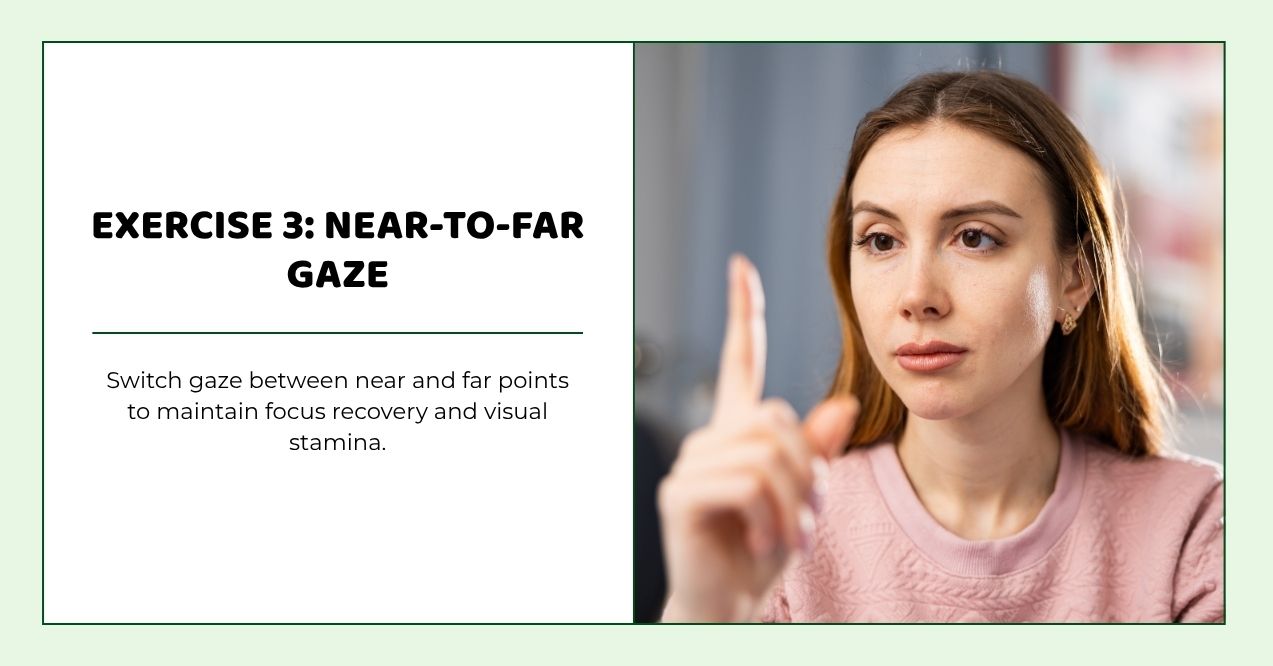
This technique alternates fixed attention between stationary objects at different distances. Position yourself near a window or in a room with depth for best results.
- Fix your gaze on text in a book or on your phone for 10 seconds
- Without moving your head, shift focus to a distant window frame or wall feature
- Hold focus on the distant object for 10 seconds
- Return your gaze to the near object
- Complete 8 to 10 full cycles at a comfortable pace
This pattern may support focus recovery after prolonged near work and can help maintain near-work stamina when practiced regularly.
Exercise 4: Convergence Work
Convergence training strengthens inward eye movement coordination. This exercise supports the coordinated inward movement both eyes need for reading and close tasks.
- Hold a pen at arm’s length directly in front of your nose
- Focus on a specific detail like the pen tip or clip
- Slowly bring the pen toward your nose while maintaining single, clear vision
- Stop immediately when you see double images
- Return the pen to starting position and pause briefly
- Repeat this movement 6 to 8 times per session
Learning why your eyesight is getting worse helps contextualize the value of this exercise.
Exercise 5: Divergence Training
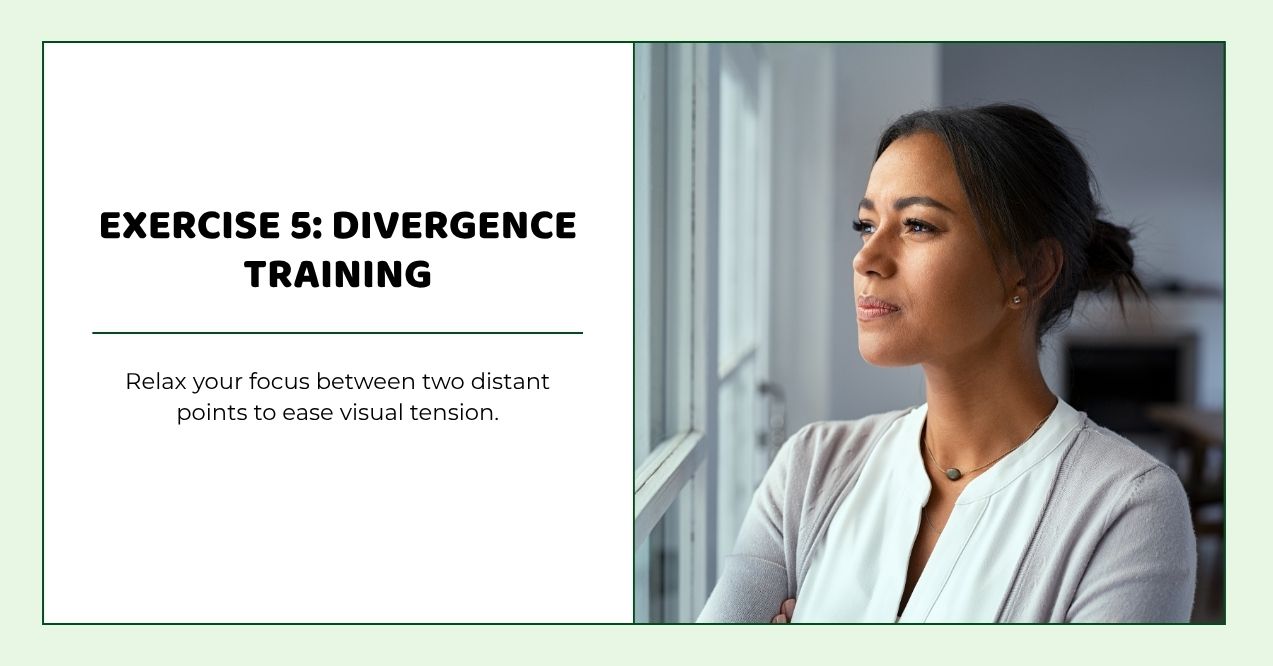
Outward visual movement gets less daily practice than convergence. This supports visual relaxation and may reduce tension from extended screen time.
- Place two small objects on a wall at shoulder height, about one meter apart
- Stand close enough that both items appear in your peripheral vision
- Focus on an imaginary point between them
- Consciously relax your focus and allow your gaze to “drift” outward
- Try to maintain awareness of both objects simultaneously without looking directly at either
- Hold this relaxed state for 20 to 30 seconds
- Blink and rest, then repeat 3 times
Exercise 6: Eye Roll and Orbital Stretch
Circular movements work multiple muscle groups simultaneously and may support circulation around the eye socket. Sit comfortably with your head level and still for this exercise.
- Roll your eyes slowly in a complete clockwise circle 5 times
- Pause briefly and close your eyes
- Complete 5 counter-clockwise rotations
- Move your gaze directly up and hold for 5 seconds
- Move your gaze down and hold for 5 seconds
- Look left and hold for 5 seconds
- Look right and hold for 5 seconds
These movements gently stretch the muscles that control eye position.
Exercise 7: Figure-Eight Gaze Path
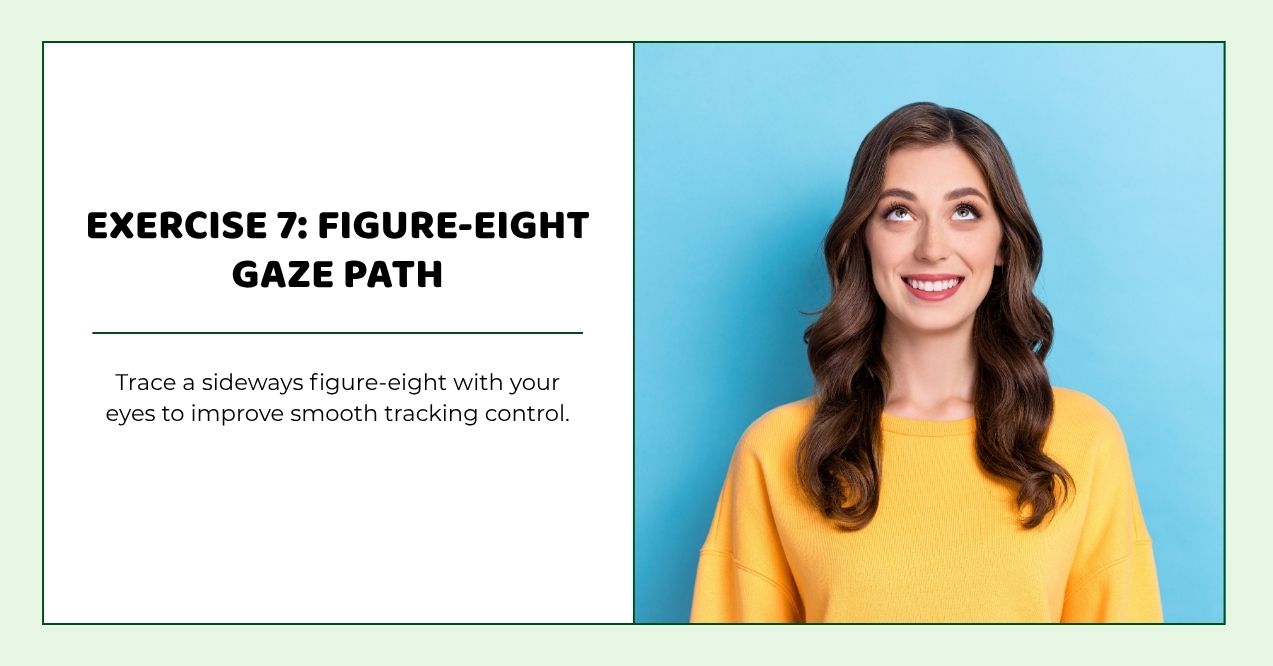
Smooth tracking movements train fine motor control and coordination. This builds the smooth pursuit movements you use when following moving objects or reading across lines of text.
- Face a blank wall and choose a point about 3 meters away at eye level
- Picture a sideways figure eight centered on that point, roughly one meter wide
- Trace this shape slowly with your eyes only, keeping your head completely still
- Continue tracing for 60 seconds in one direction
- Rest briefly and blink several times
- Reverse direction and trace the pattern for another 60 seconds
Exercise 8: Palming and Visual Reset
This relaxation technique provides a complete rest period for your visual system. This practice supports ocularen work sessions.
How to perform:
- Rub your palms together briskly for several seconds to generate warmth
- Close your eyes gently
- Place your cupped palms over your closed eyes without applying pressure to the eyeballs
- Rest your elbows on a table or desk for support
- Breathe deeply and slowly for 30 to 60 seconds
- Remove your hands slowly
- Blink slowly several times before returning to visual tasks
Darkness and warmth help relax the muscles around and within your eyes.
Integrating These Exercises Into Your Daily Routine
Consistency matters more than duration when building new habits. Short, regular sessions work better than occasional long practices. The table below shows one possible schedule for how to improve eyesight through structured practice:
| Time of Day | Duration | Exercises Selected |
| Morning | 5 minutes | Blink + Focus Shift |
| Mid-day break | 5 minutes | Convergence + Divergence |
| Evening | 5 minutes | Palming + Eye Roll |
Adapt this framework to your schedule and needs. Morning sessions prepare your eyes for the day’s visual demands. Midday breaks interrupt prolonged near work. Evening practice helps release accumulated tension. You might also wonder does wearing glasses make your eyesight worse when doing these exercises. Track which combinations feel most beneficial. Some people prefer shorter sessions more frequently. Others consolidate practice into one longer period. Natural changes occur over time, and many ask does your eyesight improve with age as they maintain their routine.
Final Thoughts
Building eye care into daily habits supports long-term visual comfort and coordination. The eight eye exercises to improve vision outlined here address different aspects of eye muscle function and visual flexibility. Combined with targeted nutritional support, these practices may help maintain visual stamina during demanding tasks.
Start with just two or three exercises and expand your routine as these movements become familiar. Consistency over weeks and months produces better results than intensive but irregular practice.
Practice 2 to 3 times daily for best results. Each session needs only 5 minutes. Morning, midday, and evening slots work well for most schedules. Consistency matters more than session length. Stop if you feel strain or discomfort.
No, they serve different functions. Exercises train muscle coordination and movement patterns. Supplements provide structural nutrients that support eye tissue. Both approaches work together for comprehensive visual support. Neither fully replaces the other.
Yes, these techniques are designed for workplace use. They require no equipment and take minimal time. Avoid exercises that cause dizziness during initial attempts. Start gently and build duration gradually. Most people can practice safely at their desk.
FAQ
References



